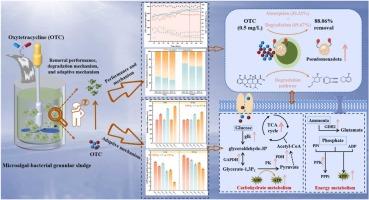微藻-细菌颗粒污泥增强土霉素去除:微生物反应,降解途径和适应机制
IF 11.3
1区 环境科学与生态学
Q1 ENGINEERING, ENVIRONMENTAL
引用次数: 0
摘要
土霉素(OTC)是一种新兴的“低浓度、高毒性”污染物,给废水处理过程带来了相当大的障碍。本研究首次系统评估了OTC对三种处理系统(微藻-细菌颗粒污泥(MBGS)、好氧颗粒污泥(AGS)和活性污泥(AS)的运行性能、污泥特性和微生物代谢活性的影响。结果表明,MBGS对500 μg/L OTC的去除率稳定在88.06±1.45% (p < 0.05)。MBGS通过增加ATP含量和减少乳酸脱氢酶释放来适应OTC暴露。驯化后的MBGS主要通过生物降解去除OTC。此外,检测到多种毒性潜力降低的OTC转化产物,表明MBGS系统实现了有效的微生物降解。宏基因组分析显示,MBGS中的假单胞菌对OTC暴露表现出高度的适应性。此外,OTC暴露上调了MBGS的碳水化合物和能量代谢,从而增强了整体微生物代谢活性。Alphaproteobacteria对关键功能基因的贡献最为显著,强调了它们在MBGS中去除污染物的关键作用。冗余分析强调了甲变形菌与抗生素耐药基因丰度之间的强大关联。这项研究证实了MBGS对otc污染废水的恢复能力,强调了它在高效抗生素废水处理方面的潜力。本文章由计算机程序翻译,如有差异,请以英文原文为准。

Microalgal-bacterial granular sludge enhances oxytetracycline removal: Microbial responses, degradation pathways, and adaptive mechanisms
Oxytetracycline (OTC), an emerging “low-concentration, high-toxicity” contaminant, presents considerable hurdles to wastewater treatment processes. This study systematically evaluated for the first time the impacts of OTC on the operational performance, sludge characteristics, and microbial metabolic activity across three treatment systems: microalgal-bacterial granular sludge (MBGS), aerobic granular sludge (AGS), and activated sludge (AS). Results demonstrated that MBGS exhibited superior treatment efficiency, maintaining stable removal of 500 μg/L OTC at 88.06 ± 1.45 % (p < 0.05). MBGS adapted to OTC exposure by increasing ATP content and reducing lactate dehydrogenase release. Acclimated MBGS primarily removed OTC through biodegradation. Moreover, multiple OTC transformation products with reduced toxic potential were detected, signifying that MBGS systems achieve efficient microbial degradation. Metagenomic analyses revealed that Pseudomonadota in MBGS displayed high adaptability under OTC exposure. Additionally, OTC exposure upregulated carbohydrate and energy metabolism in MBGS, thereby enhancing overall microbial metabolic activity. Alphaproteobacteria contributed most significantly to key functional genes, underscoring their critical role in contaminant removal in the MBGS. Redundancy analysis highlights a robust association between Alphaproteobacteria and the abundance of antibiotic resistance genes. This study confirms the MBGS's resilience to OTC-contaminated wastewater, highlighting its potential for efficient antibiotic wastewater treatment.
求助全文
通过发布文献求助,成功后即可免费获取论文全文。
去求助
来源期刊

Journal of Hazardous Materials
工程技术-工程:环境
CiteScore
25.40
自引率
5.90%
发文量
3059
审稿时长
58 days
期刊介绍:
The Journal of Hazardous Materials serves as a global platform for promoting cutting-edge research in the field of Environmental Science and Engineering. Our publication features a wide range of articles, including full-length research papers, review articles, and perspectives, with the aim of enhancing our understanding of the dangers and risks associated with various materials concerning public health and the environment. It is important to note that the term "environmental contaminants" refers specifically to substances that pose hazardous effects through contamination, while excluding those that do not have such impacts on the environment or human health. Moreover, we emphasize the distinction between wastes and hazardous materials in order to provide further clarity on the scope of the journal. We have a keen interest in exploring specific compounds and microbial agents that have adverse effects on the environment.
 求助内容:
求助内容: 应助结果提醒方式:
应助结果提醒方式:


